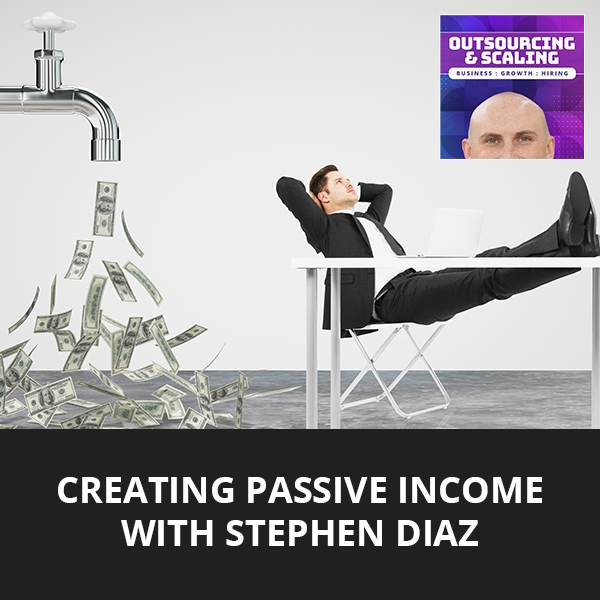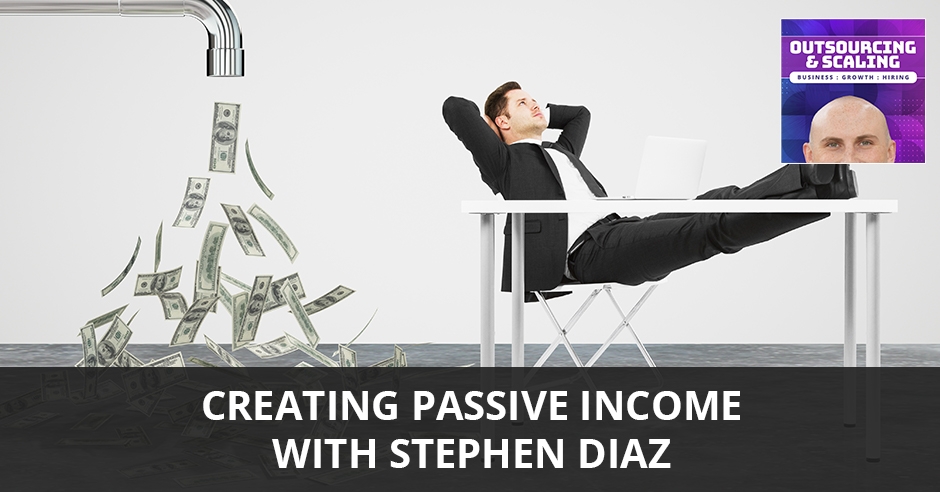


Everyone would love to have a business that pays them huge with less effort. Stephen Diaz has mastered the art of creating passive income to do just that. In 2017, Stephen and his wife established the Rainmaker Academy where they help stay-at-home moms create six-figure businesses online through Amazon FBA. In this episode, Stephen shares how they started their journey to building an online empire of cashflow-generating assets by honing their strengths and hiring out their weaknesses. He also shares how they are leveraging Instagram to its full potential and how outsourcing has helped them grow their business to new heights.
—
Listen to the podcast here:
[smart_track_player url=”https://www.podetize.com/statsapi/www.podetize.com/wp-content/uploads/fileuploads/11-5b145ef137b51b3d1af0633e9305c43d/07/2019/73748b297de3f5a63313f68a7feae3cd.mp3″ title=”Creating Passive Income with Stephen Diaz” artist=”Nathan Hirsch” image=”https://freeup.net/wp-content/uploads/2019/04/OAS.png” ]
Download the audio file here.
Creating Passive Income with Stephen Diaz
I have a very special guest, Stephen Diaz. Stephen, how are you doing?
I’m doing super well. I’m excited to be here.
We’re excited to have you. For those of you that don’t know, Stephen and his wife Chelsey are well-known for their photography and filmmaking. After years of trading dollars for hours, they mastered the art of passive income. By honing their strengths and hiring out their weaknesses, they have built an online empire of cashflow-generating assets. In 2017, Stephen and Chelsey created Rainmakers Academy, turning their attention to helping others achieve passive income online. Rainmakers Academy helps stay-at-home moms create six-figure businesses online through Amazon FBA during nap time. Throughout this journey, Stephen has developed a focus on Instagram and using the platform to drive consistent traffic and Amazon sales powerfully. Before we talk about all that, and we’re going to talk a lot about Amazon, let’s take a gigantic step back. What were you like growing up as a kid? Were you an A-plus student? Were you a rebel? Did you know you wanted to be an entrepreneur?
My mom was reminding me of my entrepreneurial tendencies as a kid. She was like, “It’s no surprise you love outsourcing stuff.” As a kid, I would pay my sister to do my chores for me. When I would have to clean my room, I’d be like, “Laura, do you want to clean my room for me? I’ll pay you.” It was some ridiculous amount. I pay her $10 or $20 to clean my room so I could play video games. I learned at an early age that if you’re willing to pay for someone to do stuff for you, it could free you up to do what you love. At the time, as a kid, it was to play Tony Hawk’s Pro Skater. I was all into that. I would pay my sister to do my chores so I could keep playing my video games. It was very entrepreneurial as a kid. I did okay in school but I wasn’t a straight-A student. That was my older sister. I was always entrepreneurial, always trying to find ways to do a little side hustle, to buy candy at Costco and sell it at school. I was always trying to think of new ways to, usually, fund what I wanted to do. Usually, it was like, “I want to buy a skateboard.” I would think about, “How can I raise money? How can I get $100 to buy a skateboard?” I was a thirteen-year-old. That’s how I got into the whole outsourcing but also entrepreneurship. It was usually out of motivation to buy something as a kid.
Did you go to college? Did you graduate from college?
Don’t ever expect love at first hire. It takes some work and some things.
Yeah, I ended up going to college to study film production. In high school, I took a video class. That’s where I fell in love with video production. I don’t think that, before that time, I had realized that you could make a career out of video. When I took it in high school, the teachers were like, “People actually do this.” I was like, “This is crazy.” I went to college and studied film production. I still do a lot of filmmaking. My wife and I do filmmaking and photography still pretty much full-time. It is one of those jobs that is trading dollars for hours. You can only make so much because you can only work so many hours in a day. You can only take so many jobs. Starting in college, I started experimenting with extra sources of income or stretching that filmmaking skill to add things onto it that would create passive income on the side.
How did you go from filmmaking to Amazon?
This is a long journey. I had started probably with Tumblr. Do you remember Tumblr?
I do remember Tumblr.
In college, I started a Tumblr blog about filmmaking. I started talking about filmmaking tips and tricks and reposting tutorials. That’s when I learned about Amazon affiliates. In their affiliate program on Amazon, you promote Amazon products. You make a tiny little cut. As a college student, this Tumblr blog got popular. I started making money on this affiliate marketing on Amazon. At the time, it was probably $20 a month. I was so stoked because I was in college. I was broke at the time so any extra money was amazing. That’s when I got the hook, the bug of affiliate marketing and passive income and being like, “I could make up stuff on the internet and make money.”

I have a funny story about that. When I proposed to my wife, I went to her dad and asked him for permission to marry her. He was asking the typical dad questions like, “You’re in college. What do you plan to do after college?” My answer to him was the most ridiculous answer. I said, “I plan to work for the internet.” I was running this Tumblr blog and I was like, “This is it. I’m going to grow this thing, be a filmmaker and make money on the internet.” That has happened since then. It’s been a slow process and building and building as we go. With Amazon specifically, I started with affiliate marketing on Amazon. I heard about FBA and went all in with private labeling, learning everything about private labeling. I was selling books and things like that wholesale. FBA is where it’s at for me. It’s where I saw the light. When I saw how much you could make on FBA and how hands-off it could be when you utilize Amazon’s warehouses and all their resources, that’s when I was like, “This is awesome.” It’s scalable and doesn’t take more of my time.
When I first moved from Connecticut to Florida, I brought my Amazon business down here and opened up an office. When we were going to rent our apartment to get an apartment, the guy asked what we did. We said, “We are an Amazon seller.” He goes, “You work for the internet.” You’re selling on Amazon. You started with books a little bit too. I did that for a while. That’s how I got into Amazon. Along that journey, I came to that decision. It was like, “Do I teach other people how to sell on Amazon or do I do it myself? You keep it secret and all your knowledge is inside your head. What made you go in that direction? If I could do it over again, I probably would’ve gone in that direction. I have the mentality of scarcity and competition, which is completely changing in the past years. What made you want to go out and teach other people to do what you are doing?
I was always hesitant to teach people. When I was in filming, I was all about teaching. I was all about, “I learned a lot of this stuff.” I went to film school, but I learned most of what I learned from other people like YouTube, where there are filmmakers ahead of me. I was all about passing on that information. That’s always been a value of mine. My mom’s a teacher and my dad’s a pastor. I feel like teaching is in me somehow. When I got into Amazon, it started with friends and family. I became what I call an Amazon evangelist. I was like, “You’ve been ordering stuff from Amazon all these years. You have no idea it’s coming from people like me.” I was telling everyone. One of the first people I taught was my mom. She’s entrepreneurial too. I was like, “You need to get into Amazon.” I started teaching her. I started teaching a small beta group. I was like, “Let’s see if I can teach people this.” I’ve found over the years that I learn more when I teach. By giving, I get a lot. If I was doing it on my own, it’s like school. In school, growing up, doing it on my own was probably Bs and Cs. In school, if I had to go teach someone, do a presentation or something, that’s when I would dive into the info and be like, “I’ve got to learn how this thing works. I can teach someone.” The teaching side of things has helped our own Amazon business and internet marketing. By giving, we’ve got a lot from learning from that teaching process.
That’s how I learn best too. Let’s talk about hiring. It’s outsourcing and scaling. Who was your first hire and how did that go?
I’ve learned over the years. Don’t ever expect love at first hire. It takes some work and some things. Thankfully, over the years, there are things like FreeUp. There are so many services now that make the process so much easier. I’m trying to think through my first online hire, a virtual assistant. We use a lot of virtual assistants for things. The first big one was when we switched our photography website from Squarespace to WordPress. We decided to switch back, which is a terrible idea to switch so many times. We had thousands of these blog posts that transfer, but none of the images were transferred. One of us, my wife or I, could rock–paper–scissors and transfer images for years or we can hire someone overseas to do it while we sleep. That was the big first like, “Let’s see if this works.” It was a pretty easy job. You just download the photos and upload them to this other site. The guy we hired was from the Philippines. He did an amazing job. It’s super-fast. That job has got to be not the most fun job, but he was so joyful in the process. He’s telling us about his family and we’re supporting his family. He still works for us to this day, doing random tasks like that. We had given him even more responsibility now, but it started with a simple thing.
When you’re starting your business, it is good to get hands-on on things to know what you’re doing.
With outsourcing, everyone is afraid to outsource. It’s hard to be in control of things sometimes. That was key for us. It’s starting with something that was very easy. I was like, “He can’t mess this up.” It’s working out from there. We do that with all of our businesses, even photography and video, even though it’s more creative, like intensive editing things. Most artists are very protective of like, “I don’t want to let someone do the editing for me because that’s my secret sauce.” Over the years, we’ve learned it’s not about that, “I’m the only person that can do it.” It’s that like, “I haven’t learned to communicate how to do it to someone else who has the skills.” It’s starting with the baby steps of the small hires, the easy tasks and then working your way up from there. That’s what I love to teach people on Amazon too, especially because we work with stay-at-home moms. They don’t have a lot of time already. I tell them like, “You could take these photos yourself with your iPhone and spend hours trying to edit them, or you can send them to this person who does it for you. Send it to this other person who edits it for you.” Starting from that place of learning to outsource right away in your business, you can grow so much faster and have so much more freedom.
I want you to think of the best virtual assistant you have, your favorite one out of all of them. What makes them so good?
It’s probably that guy Mitchell. It’s that rapport we’ve built over the years. We know about his family. We stay in touch. It’s become more than a transactional relationship. He keeps us in the loop with stuff. If he is down on work with other projects he’s doing, he’ll let us know. I can come up with more work for him. I’m in the same way. “Mitchell, we’re launching this new thing. I don’t know if it’s going to be successful yet. Are you willing to work and commit to this thing? It might only be an hour a week. Hopefully, it can grow.” We both have had our entrepreneurial journeys side-by-side. That’s been a fun relationship. We’re on total opposite sides of the world, but we’re both helping each other out. We’re both giving value and both supporting one another’s families, which is pretty wild.
Do you have any hiring horror stories that you can share?
I’m getting off-topic with Amazon, but in the wedding industry, there are a lot of people who try and do editing wedding videos specifically. That’s a hard thing to nail. I’ve seen some pretty bad wedding edits. We’ve been able to find a great company that helps us with some of the wedding editings. That can go south when maybe the freelancer doesn’t speak English and they’re trying to edit these intimate wedding vows. It ends up going the wrong way. I’ve only seen that one or two of those that we’ve tried. When you’re hiring someone, it’s good to test and try things. There are a couple of people we tried on that side of things where I was like, “I don’t think they’re going to get it, even with some work.” There are nothing too crazy horror stories yet.

Let’s talk about Amazon. The question that I always get asked is, “What should I hire first for my Amazon business?” I get to flip this on you. What should your students hire first? What should the average Amazon seller be thinking?
We work with a lot of very green, brand new and never heard of Amazon FBA before type sellers. They’re just getting their feet wet with Amazon. What I encourage them to do is to start with those things that they could maybe do themselves but it’s not worth it. It’s the photography and the editing of those photos, putting graphics on the photos, even listing optimization and things like that. When you’re starting your business, it is good to get hands-on on things to know what you’re doing. If you have a coach who’s walking you through the process and you have good systems in place, having people who can speed up that process and then you can check it is going to save you so much time. With our program, we work with stay-at-home moms to help them launch Amazon businesses. That’s one of the main focuses. It’s outsourcing a lot of those things. We teach them how to grow Instagram accounts that drive traffic to their Amazon businesses. It’s even down to outsourcing parts of that Instagram account where it doesn’t become this soul-draining part of the business where they have to spend so many hours on it. It’s something more where they can, “We can go on vacation and this thing is going to run in the background because we have our system set up.
Let’s talk about Amazon in 2019. Walk us through your strategy. We’re in the year of the brand. No one wants to build an Amazon business anymore. They want to build a brand and Amazon is one channel. Drop some knowledge on how people can do that more effectively.
Instagram is one of my focuses. It’s one small piece of the puzzle, but it is such a visual platform that it lends itself well for products, for building a brand around your product and getting your customers to fall in love with your brand. Here’s one example. Nicole is one of our students. She’s awesome. Her main product is a baby sleeper. It’s a pillow for newborns that helps them sleep. Her whole brand is built around a story. The product is named after her own son. His name is Joey. The product is named JoJo. When they had their son, he was having a hard time sleeping. They came up with this product as a solution for that. Our whole Instagram is all serving that mom customer, that new mom with a young kid. She doesn’t even post about the product that much. She’s telling her life. She’s showing the behind-the-scenes. It’s almost like that influencer model.
People are drawn towards that authentic, real life. It’s like, “Who’s the person behind this brand?” Instagram is an easy platform idea where you can share the stories and the behind-the-scenes. Every once in a while, you can say, “Here’s our product,” and link to the Amazon store. I see a lot of people doing that. There’s a lot of power in that. There are so many different social media platforms. If you’re not outsourcing, it’s hard to be on all of them. I always say that if you’re not on any, start with one, whether it’s Instagram, Pinterest or Facebook. It’s wherever your people buying the products are. Build your brand there. Getting those extra sources of traffic and extra fans can bring along in the process and connect with your brand.
Instagram is a visual platform that it lends itself well for building a brand around your product.
Are there any last tips about outsourcing, Amazon or Instagram that you want to share?
We’ve been seeing a lot of success with our students on Instagram with repost style accounts. There are different opinions with reposting accounts. One thing on Instagram is if you have to create all the content yourself, it can be very time intensive. How we’ve seen some students, and we even have a personal brand like this that gets a lot of traffic, is through themed repost accounts that are driving traffic to your product store. For example, we have a student who sells farmhouse kitchen products. They are trendy-looking, cool kitchen products. Instead of making an Instagram where it’s all his brand, only his product, he made an Instagram account called Inspired Kitchens. It’s all reposts of nice-looking kitchens. People follow that account because they love seeing cool kitchens, kitchen inspiration. Behind that brand, in his Instagram story highlights, in his bio and his link, it does say, “Check out our product of the month.” It links to his Amazon store. You can build as many of those accounts as you want and automate a lot of that process to drive traffic to your Amazon page. That’s been a fun thing we’ve been messing with. It’s creating these fan accounts based on themes instead of on the brand, but having the brand be a part of that where it is driving traffic to the Amazon store from all these platforms.
Stephen, this has been awesome. I learned a lot. I’ve been trying to figure out Instagram. If you asked me back then anything about Instagram, I wouldn’t be able to tell you. Where can people find out more about you? What are you most excited for?
If you’re interested in Instagram, we have a free Instagram course. It’s SwipeUpSecrets.com. I went on Facebook. It was the same thing when I was learning all the Instagram stuff. I wanted to teach it. I went on Facebook and taught a group of friends pretty much all these crazy Instagram techniques that I saw mega influencers are using on Instagram. Not all of them are recommended, but I wanted to break everything down that people are doing. A lot of the stuff you see on Instagram is manipulated. There are a lot of people manipulating the algorithm and things like that. I wanted to expose all that stuff in one course but then say, “Now you know everything. You can choose if you want to do this or this,” whatever makes sense. We talked about influencer marketing, Instagram automation and all those things in that course. That’s free. If anyone has any questions about Amazon or Instagram, you can hit me up on Instagram. My Instagram is @SteezDiaz.
Thanks so much for coming on. I’m sure we’ll be in touch.
Thanks, Nathan. Talk to you soon.
Important Links:
- Rainmakers Academy
- SwipeUpSecrets.com
- @SteezDiaz – Instagram
About Stephen Diaz
 Stephen Diaz and his wife Chelsey are well known for their photography and filmmaking, but after years of “trading dollars for hours” they mastered the art of passive income. By honing their strengths and hiring out their weaknesses they have built an online empire of cash flow generating assets.
Stephen Diaz and his wife Chelsey are well known for their photography and filmmaking, but after years of “trading dollars for hours” they mastered the art of passive income. By honing their strengths and hiring out their weaknesses they have built an online empire of cash flow generating assets.
In 2017, Stephen&Chelsey created Rainmakers Academy, turning their attention to helping others achieve passive income online. Rainmakers Academy helps stay at home moms create six-figure businesses online through Amazon FBA (during nap time). Throughout this journey, Stephen has developed a focus on Instagram and using the platform to powerfully drive consistent traffic and Amazon sales.
